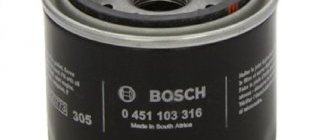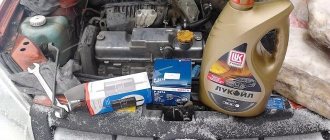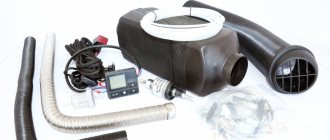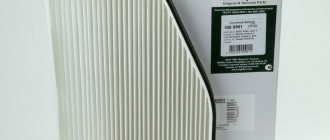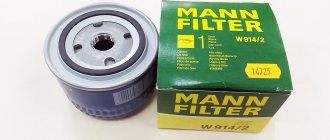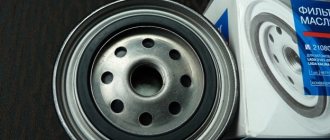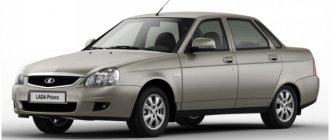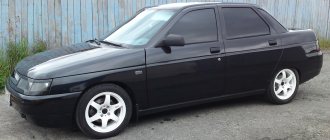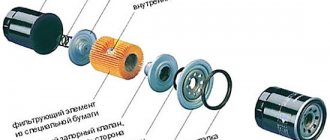The oil filter is designed to remove contaminants from motor, transmission and lubricating oils. The oil filter cleans the oil pumped through it from abrasive particles, carbon deposits, and metal shavings, which cause increased wear of the rubbing parts of the engine and transmission. Oil filters require regular replacement. A large number of companies in the world are engaged in the production of oil filters. The quality of filters from different manufacturers varies greatly.
What is an oil filter for?
The oil filter is designed to clean the oil from contaminants and provides several important functions at once:
- The oil filter allows you to maintain an optimal level of oil viscosity.
- Protects internal engine parts from corrosion, carbon deposits and oil deposits.
- Ensures maintenance of oil performance characteristics throughout the entire service interval.
The degree of oil contamination depends on the operating mode of the engine and its technical condition, as well as on the quality of the oil and fuel used. The degree of oil purification by a filter depends on the characteristics of the oil filter, the type of contaminants, and the temperature of the filtered oil.
Advantages and disadvantages
Full-flow filters are characterized by effective cleaning of the oil mixture, but are subject to contamination with subsequent opening of the bypass valve.
Partial flow models divide the channels into 2 streams.
This improves the quality of cleaning, but makes it take longer.
Combined releases combine the advantages of the previous 2 options and are used for increased loads. Their disadvantage is their high cost.
Types of Oil Filters
There are several types of oil filters:
- Mechanical oil filters
are the most common type of filter and use a filtration method to remove impurities. Mechanical filters can be of two types: non-separable and collapsible. When dirty, non-separable mechanical filters are removed and replaced with new ones. Collapsible mechanical filters consist of a collapsible housing and a replaceable filter element. Depending on the type of filter element, mechanical filters can be: paper, mesh, felt, wire and plate. In modern cars, non-separable mechanical filters with a paper filter element are most often used. - Gravity settling filters
are a transparent glass in which heavy impurities precipitate under the influence of gravity. The screw plug of the sedimentation tank is periodically unscrewed and part of the oil with impurities contained in the sediment is drained. In modern cars, such filters are practically not used. - Centrifugal filters (centrifuges)
are a type of oil filters in which oil is purified from impurities using centrifugal force in a centrifuge. Solid particles contained in the oil settle in the filter cover, and the purified oil enters the oil line. Centrifugal oil filters are used in cars: ZAZ-965, GAZ-53, ZIL-130, KAMAZ. In modern passenger cars, such filters are practically not used. - Magnetic filters
- use a magnet to remove metallic contaminants from the oil. Most often, the magnet is built into the drain plug of the engine or transmission pan. When changing the oil, adhered metal shavings are removed from the magnet. In a working internal combustion engine, the main part of the contamination consists of wear products of the main and connecting rod bearings of the crankshaft, the working surfaces of which usually consist of Babbitt or aluminum and are of a non-magnetic nature, therefore magnets are less effective on the engine sump than on the gearbox.
Oil filters are also divided into:
- full-flow
- they clean the entire flow of oil entering the engine through the oil pump. Be sure to include a bypass valve, which ensures lubrication of engine parts when pressure drops in the event of a clogged filter. - Partial flow
- oil is supplied to the engine both through the filter and in addition to it. Partial flow filters filter the oil more thoroughly, and filter contamination does not affect the pressure level, but such filters require more time to completely clean the oil.
Rating of the best manufacturers
When reviewing the best suppliers of filtration devices, you can consider the following brands:
- "BelMag". The company specializes in the production of spare parts for VAZ-2106, Lada Grant, Priora and Kalina. In addition, the brand’s assortment includes filters for cars from foreign automakers, including Renault and Nissan.
- Sakura. The brand has made a lot of efforts to modernize the production process, reducing the defect rate to a minimum. The service life of models from this company is 10 thousand km.
- Finwhale. The German parts supplier is actively selling its products in Russia. They enjoy a good reputation due to their affordable prices and wide range of items. In total, the brand’s catalog contains more than 200 types of filters with an average working life of 15-20 thousand km.
- "Auto-unit". Russian manufacturer of spare parts for cars and trucks. The bulk of components are supplied to VAZ, KamAZ, Ural, etc. factories.
- Goodwill. It produces parts in all price ranges - budget, medium, premium. During testing, experts determined that the service life of products from the brand is 15-20 thousand km.
Oil filter device
Modern cars are most often equipped with non-separable mechanical oil filters with a paper filter element, which all have approximately the same design.
The filter housing has the form of a thin-walled metal cup, closed on top with a rolled thick-walled metal lid. There are several holes in the cover through which crude oil enters the filter. The oil passes through the filter element and, already cleaned, flows through the central threaded hole back into the engine. The central threaded hole also serves to attach the filter to the engine, screwing it to the threaded pipe on the engine.
On the outside of the cover there is a rubber O-ring that ensures a tight connection between the filter and the engine. The O-ring can have a rectangular, round or semi-circular profile.
The main element of the oil filter is the filter coil, which is an internal cage made of perforated metal sheet with holes for the passage of oil, around which the filter material is located.
Filter paper is most often used as a filter material; fibrous materials are used less frequently. To increase the filtration area, the filter paper is laid with corrugations in the form of a multi-beam star. The corrugations are usually even, sometimes in the form of chevrons. The filter coil inside the filter housing is often pressed by a spring.
The design of oil filters may include several valves: bypass, anti-drainage and anti-drain.
- The anti-drainage valve is an elastic ring made of regular or silicone rubber and closes the inlet holes in the filter housing from the inside. The anti-drainage valve prevents oil from draining from the filter into the engine crankcase after it is stopped, which eliminates the formation of an air lock and delay in the supply of oil to the lubrication system when starting the engine, and also prevents the flow of dirty oil from the outside of the filter coil into the cavity with purified oil inside the central race.
- The bypass valve is usually located on the other side of the filter coil and is a spring-loaded plate that closes the hole in the end of the coil. When the bypass valve opens, it allows oil to pass directly past the filter coil and into the engine without purification. The bypass valve protects the engine from oil starvation if for some reason the filter coil stops passing oil. For example, when the filter is clogged with wear products, when the oil is too thick due to low air temperature, or when the engine accelerates sharply, when due to a sharp increase in pressure in the oil system, the filter material may not be able to cope with pumping the sharply increased volume of oil.
- An anti-drain valve is sometimes installed in permanent filters in combination with a bypass or anti-drain valve. The anti-drain valve prevents oil from pouring out of the housing through the outlet when replacing the used filter.
Which company to choose
When choosing the best automotive oil filter, you should analyze the top suppliers and also take into account the following product characteristics:
- Assortment - study the types of spare parts, their technical characteristics.
- Price Range – Make sure the price matches the quality. Leading companies offer products in both the budget and premium segments.
- Availability of a warranty agreement - inquire about the filter service life declared by the manufacturer and whether there is a warranty.
- Build quality - ask the sellers what materials were used in the production of the product, because... they determine its durability and reliability.
- Specialization - become familiar with the focus of the product. While some companies produce components only for foreign cars, others also work on the domestic market, supplying parts for Russian-made cars.
Replacing the oil filter
Oil filters become dirty during operation and require periodic maintenance or replacement.
Most modern oil filters have a non-separable design and are installed on the engine by screwing onto the threaded inlet pipe of the engine lubrication system. Such filters are changed every time the oil in the car is changed.
When replacing the oil filter, it must be tightened with a certain force. If the filter is not tightened enough, then when the engine is running, oil under pressure will be squeezed out from under the loose gasket, which over time can lead to oil starvation and engine failure. If you tighten the filter too much, you can either strip the threads on the intake pipe or damage the gasket, which will also allow oil to pass through.
When replacing the oil filter, several important rules should be followed:
- Before screwing the oil filter to the engine intake pipe, you should lubricate the surface of the gasket with engine oil so that the gasket slides better over the seating surface, does not wrinkle and does not create the illusion of sufficient tightening torque.
- The oil filter must be screwed on by hand until the filter gasket touches the seating surface.
- Tighten the oil filter another ¾ turn; this will be enough to properly tighten the filter and ensure the required tightness of the connection.
In some cases, after changing the oil and oil filter, an air lock may form. The formation of an air lock is indicated by the red light indicator of insufficient engine oil pressure, which continues to light for more than 30 seconds after starting the engine.
To resolve the air lock problem, follow these steps:
- turn off the engine.
- Unscrew the oil filter to loosen the gasket.
- Turn off the ignition system and crank the engine with the starter until oil appears from under the filter gasket.
- Close the oil filter and remove any oil leaks.
- Connect the ignition system.
- Start the engine, the low engine oil pressure indicator should go out in less than 10 seconds.
Recommended for purchase
There are no universal spare parts for all car brands. You need a competent selection of consumables for your car. The VyborExperta.ru team recommends taking into account not only the model, but also the reputation of the brands. Our experts recommend the following models:
- Lada 21050-1012005-82 – for owners of domestic cars;
- Mann-Filter W 914/2 - for Chevrolet and inexpensive European cars;
- Sakura C-1809 – the choice of Mazda owners;
- Filtron OP 629 - an inexpensive solution for Skoda;
- Marshall ML7056 - will increase the service life of Toyota.
All the brands presented in the review are worthy of the attention of car owners, but only the most reliable ones received the status of the best in their categories.
How to choose an oil filter
When choosing an oil filter for your car, you should follow several rules:
- The oil filter must match your vehicle. You should select an oil filter from manufacturer catalogs, using information about the car and engine model or its identification number (VIN).
- You should not install on your car an oil filter that is not intended for your car, even if it matches the overall dimensions, connecting threads, seals and the number of built-in valves.
- Don't skimp on the cost of an oil filter. The cost of repairing the simplest engine is several times higher than the cost of the most expensive oil filter.
- Beware of fakes, buy an oil filter only in large auto parts stores or branded service centers. Counterfeits often have traces of welding on the body, mechanical damage, burrs on the threads, unclear, uneven inscriptions and drawings on the packaging or on the filter itself.
- A high-quality oil filter from a good manufacturer should have a body made of durable metal, there should be no dents, burrs or other defects on its surface, the O-ring should fit snugly against the body and not be damaged, the threads should not have burrs, and should not rattle when the filter is shaken no rattles.
- You can find out in advance about the quality of the filter element and valves from cutting tests, which can be found on the Internet. The filter element of the filter must have a large number of corrugations, which must be distributed evenly.
What to look for when choosing
The best choice would be to buy an original filter from a trusted brand. For any car, there is specific advice from automakers on installing the correct filter - its overall dimensions, brand, characteristics and how often it should be changed. But such products are often very expensive, and they are purchased through third parties or from third-party manufacturers. Plus, there are many fakes of famous brands.
You can find a filter from another brand at a lower price, but with the same characteristics. However, to do this you need to know what to look for when buying, namely:
- Appearance – you should carefully examine not only the filter itself, but also its packaging. Leading and simply self-respecting automakers make sure that the products produced under their name look decent. The packaging and the filter itself should not show signs of poor painting, defects in threads or body, all inscriptions and markings must strictly correspond to reality. In general, a high-quality filter should have a solid appearance.
- Protective polyethylene - this is not so important, but its presence increases the reliability of storage. This way you will be sure that the internal parts have not been corroded. Its presence will give you confidence in the quality of the purchased product.
- The area of the working surface of the filter and the material of its manufacture. You can find out such parameters by studying the documentation or simply disassembling the product. Of course, when purchasing, no one will allow you to disassemble the filter, so ask the seller, look at the technical documentation, or you can read information about the product you are interested in at home on the Internet in advance.
- Design - the ideal option would be to buy a filter exactly the same as the old one. If there are still differences, then you should ask for what purposes such design changes were made. Often this is a more modern solution to some problem.
- The quality of the thread - the reliability and quality of fit on the workplace depends on this. And in the future, ease of change using a special puller.
- The design and reliability of the valve - it must be structurally similar to the original oil filter. Naturally having only high quality, the bypass valve must be equipped with a special, and not a universal, spring, ensuring operation in strict accordance with the pressure. The anti-drainage valve is made of high-quality materials, without uneven edges, chips, etc.
- Sealing ring - in good filters it is rolled so that it is difficult to remove from its seat. If it can be removed without any problems or even falls out, then it is most likely a fake or defective. It is not worth buying such a product.
- The quality of the filter element - it must be laid in a beautiful accordion-like arrangement in the housing with the same distance between the fins. The entire space is filled with filter material; the amount should not be too small.
- Traces of corrosion - if there are any, the product in front of you is of low quality, and possibly a fake. The body and all components of good filters are treated with anti-corrosion agents to prevent rust.
To make the right choice, you should also remember that manufacturers are divided into two categories. The first ones are produced for specific brands or groups of cars. The second is often a huge company that produces a large selection of filters for different cars and are more universal, which is not always suitable for the end consumer. For example, for South Korean, Chinese and Japanese cars, the best choice would be Japanese-made oil filters. For European cars - European products, for American ones - respectively, American-made.
There is another popular method for checking the quality of an oil filter. To do this, shake the product well or place it on a flat surface and hit the body with the edge of your palm. After these actions, nothing should rattle or vibrate inside it. If sounds or vibrations are present, the filter is of poor quality.
It should also be remembered that in addition to a high-quality filter, it is necessary to choose high-quality motor oil, as well as replace it in a timely manner.
Filtration principle
In 75% of engines, the oil filter is positioned with the thread down, so it works as follows:
- under pressure from the oil pump, the check valve membrane is raised;
- the working medium enters the filter cartridge;
- there is no pressure when the engine is turned off;
- The oil contained inside the filter presses on the membrane from above, closing the check valve with its own weight.
Operating principle of the oil filter
The bypass valve spring is designed for a certain pressure inside the system. This bypass unit is necessary every time you start the internal combustion engine, when thick, cold oil cannot yet pass through the filter curtain material. To avoid oil starvation of the motor, the bypass valve opens slightly and lubricant enters the internal combustion engine, bypassing the filter cartridge.
The system operates in a similar way when the curtain is completely clogged until the filter is replaced during maintenance.
Filter Mann W 712-75 without bypass valve
Paper curtain
When supplying engine oil filters, manufacturers follow industry and government standards. Some characteristics, for example, the opening pressure of the bypass valve, are regulated by technical specifications.
Only companies whose products comply with international standards - ISO 4548 are suitable for the definition of leading brands. The human eye distinguishes hair with a thickness of 70 microns and 40 microns, but in the latter case it is already at the limit of visibility. Without a microscope, a person will not know what bacteria 2 microns in size and soot particles 0.6 microns in size look like.
Curtains of filter elements made of pleated and corrugated paper trap contaminants up to a maximum size of 40 microns. To increase filtration efficiency, synthetics are used.
With a two hundredfold magnification of the structure, you can compare the difference between paper and synthetics (left, right, respectively).
Structure of filter materials
The main differences between paper filters are:
- the presence inside a protective cage that retains pieces of paper when the cartridge is destroyed;
- Curtain ribs can be straight or zigzag, and can have different densities and quantities.
Cassette without protective clip
Zigzag filter fins
Unfortunately, it is almost impossible to see the density and number of curtain ribs through the threaded hole. But when compiling the next rating, experts cut non-separable cases and evaluate the specified parameters, making the information accessible to users.
Synthetic cartridge
Synthetics have recently been used in cartridges. For example, an option with a filtration degree of 10 microns was found only in the DC line of the manufacturer VIC. It is quite logical that the cartridge is designed for oils with low viscosity, and the product life is 6 thousand kilometers maximum.
Synthetic curtain material
Logistics workplace
The processing can display delivery addresses on a Google map, allows you to manually break them down by route (cars and drivers), including visually, coloring points on the map in the colors of the cars, build a detailed route for each car, optimized according to the order of visiting delivery points (deciding "traveling salesman problem" for each route). Processing does not use any configuration metadata - delivery addresses and data of cars and drivers are loaded from Excel files, the final routes are also uploaded to Excel. The archive contains the processing itself, examples of Excel files with addresses and data of drivers and cars, as well as one file for the final upload of the resulting route.
10 startmoney
EGAIS 3 Controller for 1C: Retail
Protect yourself from the risks of revocation of your license to sell alcohol, fines and blocking in the Unified State Automated Information System. Check incoming alcoholic beverages individually for compliance with TTN EGAIS v3 before confirming receipt and accepting it for balance in EGAIS. From 07/01/2018, the Unified State Automated Information System (EGAIS) begins the transition to mark-based accounting of alcoholic products at all stages of product distribution, starting from production or import into the territory of Russia, to sales in retail trade, the so-called. "EGAIS 3.0". In standard Retail, processing for monitoring received excise stamps has already appeared on the PC. I suggest you familiarize yourself with the mobile solution. Control is carried out in the Android application on the TSD or on a regular smartphone.
1 startmoney
